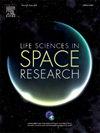Effect of fluorescence in situ hybridization detection threshold on chromosome aberration counting: a simulation study
IF 2.8
3区 生物学
Q2 ASTRONOMY & ASTROPHYSICS
引用次数: 0
Abstract
Purpose
Radiation-induced carcinogenesis remains one of the main hurdles for long duration missions in deep space. The space radiation environment is diverse and includes high linear energy transfer (LET) ions that are particularly effective at inducing adverse health outcomes including cancer. Quantifying the health effects of these high-LET ions is difficult, and large uncertainties remain in cancer risk projections. Chromosome aberrations are a biomarker of radiation-induced cancer used to assess radiation quality effects. Fluorescence in situ hybridization (FISH) measurements of simple and complex exchanges have inherent detection limitations that might underestimate the overall number of chromosomal rearrangements, possibly affecting estimates of the relative biological effectiveness of high-LET ions.
Material and methods
In this work, we introduced a new chromosome aberration classification approach in the simulation code RITCARD (Radiation induced tracks, chromosome aberrations, repair, and damage), that accounts for FISH detection threshold and the use of different chromosome painting probes. We also modified our 3D nuclear architecture model using Hi-C data to generate the DNA distribution within cell nuclei with the tool G-NOME. This new approach allowed the discrimination of true simple and complex exchanges from apparently simple exchanges (complex exchanges detected as simple), as well as undetected exchanges.
Results
We compared the results of this new classification method in the RITCARD tool with experimental FISH data obtained for the staining of 3 pairs of chromosomes (referred to as 3-FISH), and found an overall good agreement of the total exchanges for fibroblasts (hTERT 82-6) and lymphocytes (whole blood) for high LET ions, a slight underestimation in the low LET range (< ∼ 20 keV/µm), and a slight imbalance between simple and complex exchanges for lymphocytes. The model reproduced well the higher yield of aberrations for lymphocytes, compared to fibroblasts. Remarkably, in our model, this higher yield was solely due to differences in nuclear geometries and repair time between the two cell types, both derived from experimental data. For both cell types, we observed an increased number of complex exchanges detected as simple, and an increased number of undetected simple exchanges for high LET ions when we increased the detection threshold. For lymphocytes, this resulted in an overall increased number of simple exchanges, while, for fibroblasts, simple exchanges remained largely unchanged. Overall, the number of total exchanges decreased with increased detection threshold for both cell types. We also found that, for high LET ions, the majority of detected simple exchanges were true complex exchanges, due to many intra-chromosomal rearrangements that are undetected with traditional FISH technique.
Perspectives
Our new chromosome aberration classification approach allows us to go beyond FISH detection limitations and quantify how they impact aberration yields. Our simulation results suggest that, for high LET exposure, 3-FISH underestimates the total number of exchanges as well as their complexity, due to the inability to detect small fragments and intra-chromosomal rearrangements. Future work will focus on optimizing the model parameters to better reproduce low LET measurements. Once validated, RITCARD predictions may be used in the NASA cancer model to inform radiation quality factors as part of an ensemble framework. We also intend to investigate how predictions obtained with partial chromosome staining (3-FISH) compares with predictions obtained with whole genome staining (mFISH), and how both compare with predictions of true exchanges, where all exchanges are accounted for, included those undetectable by traditional FISH such as inversion or small deletions.
荧光原位杂交检测阈值对染色体畸变计数的影响:模拟研究
目的:辐射致癌仍然是深空长期任务的主要障碍之一。空间辐射环境多种多样,包括高线性能量转移(LET)离子,这些离子在诱发包括癌症在内的不良健康后果方面特别有效。量化这些高let离子对健康的影响是困难的,而且在癌症风险预测中仍存在很大的不确定性。染色体畸变是辐射致癌的生物标志物,用于评价辐射质量效应。荧光原位杂交(FISH)测量简单和复杂交换具有固有的检测局限性,可能低估了染色体重排的总数,可能影响对高let离子相对生物学有效性的估计。在这项工作中,我们在模拟代码RITCARD(辐射诱导轨迹,染色体畸变,修复和损伤)中引入了一种新的染色体畸变分类方法,该方法考虑了FISH检测阈值和使用不同的染色体涂漆探针。我们还利用Hi-C数据修改了我们的三维核结构模型,用G-NOME工具生成细胞核内的DNA分布。这种新方法可以区分真正的简单和复杂的交易所,从表面上简单的交易所(复杂的交易所被检测为简单),以及未被检测到的交易所。结果我们将RITCARD工具中这种新分类方法的结果与3对染色体染色的实验FISH数据(称为3-FISH)进行了比较,发现成纤维细胞(hTERT 82-6)和淋巴细胞(全血)的高LET离子交换总体上很一致,在低LET范围(<;~ 20 keV/µm),淋巴细胞的简单交换和复杂交换略有不平衡。与成纤维细胞相比,该模型复制淋巴细胞畸变率较高。值得注意的是,在我们的模型中,这种更高的产量仅仅是由于两种细胞类型之间的核几何形状和修复时间的差异,两者都是从实验数据中得出的。对于这两种细胞类型,我们观察到,当我们提高检测阈值时,检测到的简单复杂交换数量增加,而未检测到的高LET离子简单交换数量增加。对于淋巴细胞,这导致简单交换的总体数量增加,而对于成纤维细胞,简单交换基本保持不变。总的来说,两种细胞类型的总交换次数随着检测阈值的增加而减少。我们还发现,对于高LET离子,由于传统FISH技术无法检测到许多染色体内重排,因此大多数检测到的简单交换都是真正的复杂交换。我们新的染色体畸变分类方法使我们能够超越FISH检测限制,并量化它们如何影响畸变产量。我们的模拟结果表明,对于高LET暴露,由于无法检测小片段和染色体内重排,3-FISH低估了交换的总数及其复杂性。未来的工作将集中于优化模型参数,以更好地再现低LET测量值。一旦得到验证,RITCARD预测可用于NASA癌症模型,作为整体框架的一部分,告知辐射质量因素。我们还打算研究部分染色体染色(3-FISH)获得的预测结果与全基因组染色(mFISH)获得的预测结果如何比较,以及两者与真实交换的预测结果如何比较,其中所有交换都被考虑在内,包括那些传统FISH无法检测到的交换,如倒置或小缺失。
本文章由计算机程序翻译,如有差异,请以英文原文为准。
求助全文
约1分钟内获得全文
求助全文
来源期刊

Life Sciences in Space Research
Agricultural and Biological Sciences-Agricultural and Biological Sciences (miscellaneous)
CiteScore
5.30
自引率
8.00%
发文量
69
期刊介绍:
Life Sciences in Space Research publishes high quality original research and review articles in areas previously covered by the Life Sciences section of COSPAR''s other society journal Advances in Space Research.
Life Sciences in Space Research features an editorial team of top scientists in the space radiation field and guarantees a fast turnaround time from submission to editorial decision.
 求助内容:
求助内容: 应助结果提醒方式:
应助结果提醒方式:


